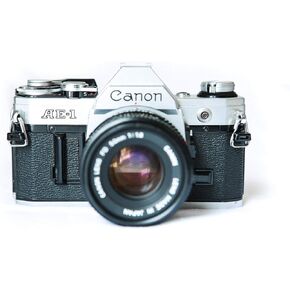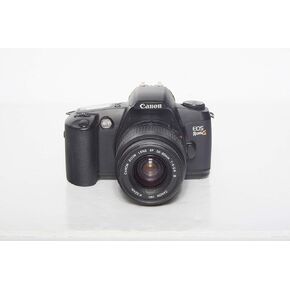- Shopping, made easy.
- /
- Get the app!
Introduced in April 1976, the AE-1 was a very successful camera worldwide. When the AE-1 came out, TTL manual-metering models (including the Canon FTb and FTb-N) were still the mainstream in the 35mm SLR market. Auto-exposure models were still at the very top end of the SLR market. They were expensive and produced in small numbers. The AE-1, however, was designed from the ground up with five major units and twenty-five minor units. They were centrally controlled by a microcomputer. By incorporating electronics, the parts count could be reduced by 300. The manufacturing of the camera was also highly automated. This made it possible to produce a low-cost camera having high-end features. Shutter Four-axis, horizontal-travel focal-plane shutter with cloth curtains. X, B, 2, 1, 1/2, 1/4, 1/8, 1/15, 1/30, 1/60, 1/125, 1/250, 1/500, 1/1000 sec. All speeds controlled electronically. Built-in self-timer (with blinking LED). Viewfinder Fixed eye-level pentaprism. 0.86x magnification (EX 50mm), 93.5% vertical coverage, 96% horizontal coverage. Split-image rangefinder encircled by microprism rangefinder at center with a fresnel matte screen. Exposure meter needle, aperture scale, overexposure warning, stopped-down aperture metering needle and battery check indicator, and underexposure warning LED provided. Exposure Control SPC for TTL full-aperture metering with shutter speed-priority AE or TTL stopped-down match needle manual metering (center-weighted averaging). Exposure compensation range of +1.5 EV. Metering range at ISO 100 and f/1.4: EV 1 – 18. Film speed range from ISO 25 to 3200.
 Canon AE-1 Program 35mm SLR Camera with 50mm 1:1.8 Lens (Black) (Renewed)
KWD 106.500
Canon AE-1 Program 35mm SLR Camera with 50mm 1:1.8 Lens (Black) (Renewed)
KWD 106.500
 Minolta X-700 35MM SLR Film Camera with MD mount lens System. Included 50mm f/2 Manual Focus Lens (Renewed)
KWD 89
Minolta X-700 35MM SLR Film Camera with MD mount lens System. Included 50mm f/2 Manual Focus Lens (Renewed)
KWD 89
 Vintage Canon AE-1 35mm SLR Camera with 50mm 1:1.8 Lens (Renewed)
KWD 113
Vintage Canon AE-1 35mm SLR Camera with 50mm 1:1.8 Lens (Renewed)
KWD 113
 Canon EOS Rebel G 35MM SLR Film SLR Camera Kit with Auto Focusing AF Zoom Lens. Uses Canon EF mount lenses. (Renewed)
KWD 62
Canon EOS Rebel G 35MM SLR Film SLR Camera Kit with Auto Focusing AF Zoom Lens. Uses Canon EF mount lenses. (Renewed)
KWD 62